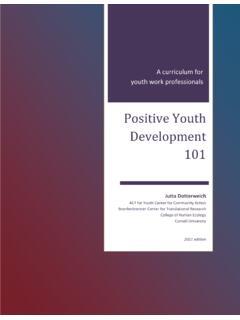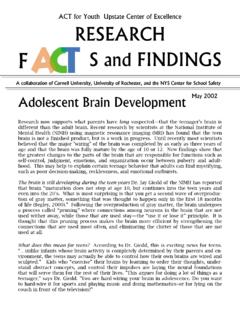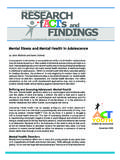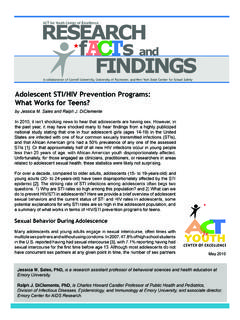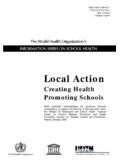Transcription of Understanding Youth Development September 2004 …
1 Understanding Youth DevelopmentPrinciples and Practicesby Janis WhitlockSeptember 2004 Continued on page 2 Youth Development (YD) is a strategic approach with a focuson practices for engaging entire communities in helping allyouth thrive. It builds on traditional Youth service approachesby emphasizing long term, systemic strategies for cultivatingqualities and traits desirable in young people through thecreation of environments that support their developmentalneeds and capacities. The YD approach is founded on thebelief that young people thrive when they are developmentallysupported across all sectors of the community school, youthserving agencies, faith organizations, community governance,business, juvenile justice system and YD framework is a descendant of resilience studies inthe early 1980 s when scholars began to explore why somechildren and Youth achieved a healthy, even happy, adulthooddespite serious adversity (Rutter 1985; Werner and Smith1992).
2 It also evolved from best practices/lessons learned inthe prevention field prior to the 1990 s: cross agencycollaboration, client-driven program planning and services,loosening of restrictions on categorical funding, and theacknowledgment of the interwoven roles of families,classrooms, schools, peers, neighborhoods, and largercommunities in influencing outcomes of children andadolescents (Wynn, Costello, Halpern, & Richman, 1994).YD stresses the role of communities in creating what hasbecome widely known as SOS : Services, Opportunities,and Supports (Pittman, et al 2001). However, although SOShas become common place in YD, it is not always clear what services, supports, and opportunities look like or how theydiffer from what most communities already have in remainder of this fACT sheet is designed to review keyfeatures of the YD framework in hopes of fostering a clearlydefined Youth Development are Services, Supports, and Opportunities?
3 The SOS framework articulates principles and practices entirecommunities can engage in to enhance optimal : Actions done to or for Youth intended to enhancehealth, safety, performance, and other forms of essential wellbeing and physiological functioning. These are the traditionalprimary, secondary, and, to some extent, tertiary interventionservices provided by public health systems, school districtsand recreational projects/facilities. They are critical, but alone,are inadequate for fostering well : Simply, these are actions by young people,where Youth become actors rather than recipients. The O inthe SOS trilogy represents the extent to which Youth areprovided meaningful and real opportunities to practice andexpand on what they know and learn either through work,2 Linking Theory and Practice:Community Programs to PromoteYouth DevelopmentIn early 1999, a committee composed of national youthdevelopment leaders launched an initiative to cull lessonslearned from adolescent health research and practice;they identified nine features of positive developmentalsettings.
4 When the following conditions are present inall Youth occupied environments, adolescents are bestpositioned to thrive (Eccles et. al., 2002). Physical and psychological safety Appropriate structures that provide: limit setting; clear,consistent rules and expectations; continuity andpredictability; and age appropriate monitoring. Supportive relationships characterized by warmth andcloseness. Connectedness, caring, support and responsiveness. Opportunities to belong and for meaningful inclusionregardless of demographics or abilities. Positive social norms with clear rules for behavior,expectations, values and morals. Support for efficacy and mattering that includesenabling, responsibility and meaningful challenge.
5 Opportunities for skill building. Integration of family, school and community Development : The capacities, perceptions, andneeds of Youth vary dramatically. Youth developmentstrategies recognize that age combined with individual interestand ability play a strong role in what Youth need to and groups should develop services, supports, andopportunities Voice: Viewing Youth as resources rather than asproblems or service recipients is a core YD principle. Youthparticipation can take different shapes from youthexpression, to Youth assisting in program planning andimplementation, to Youth sitting on decision-making of how Youth are involved, Youth voice challengesadults to rethink how they engage young people in the processof planning, developing and implementing opportunities foryoung in ProgramsYouth serving programs have a critical role to play in providingthe SOS that young people need.
6 While they can strive to supporta wide and diverse array of services, supports, and opportunities,they can also work with other agencies, Youth -serving programs,schools, families, peer groups, and community institutions topromote collaborative strategies focused on:Positive Outcomes: Emphasize the importance of trackingnegative outcomes such as: teen pregnancy, substance abuse,and violence in relation to positive outcomes such as:competence (academic, social, vocational skills), self-confidence, connectedness (healthy relationship to community,friends, and family), character (integrity, moral commitment),caring and , or advanced learning. Although Youth ideally encountera diverse array of opportunities, those which are sustained andencourage Youth to exercise meaningful decision making rolesultimately foster the greatest number of personal competencies(Zeldin, McDaniel, Topitzes, and Lorens 2001).
7 Supports: Tangible activities that are done with Youth tofacilitate access to interpersonal relationships and et al. identify three main categories of support:emotional, motivational, and strategic all of which workseparately and together to foster positive Development . Takenas a whole, supports promote a positive climate for support facilitates a sense of safety, nurturing andfriendship. Motivational support provides positive expectations,guidance and developmentally appropriate boundaries. Strategicsupport facilitates access to needed resources and Community Strategy Not Just a Program StrategyBecause Youth and adults are integral to each other s developmentand wellbeing (Erikson, 1979) it is important to createdevelopmentally attentive communities and not justdevelopmentally attentive programs.
8 Despite our best intentions, Youth and adults often lead very separate lives. Keeping youthin places and programs which rarely, if ever, involve sustainedcontact with adults other than program staff, fails to provideyoung people realistic opportunities to assess interest in andpotential for working or participating in vocations within thebroader community. Moreover, no one program can ensure thata young person encounters all of the SOS he or she needs. Youthdevelopment is founded on the idea that when schools, youthserving organizations, businesses, civic organizations,community government, and faith institutions intentionallyprovide services, opportunities, and/or supports to youthindividual young people will accrue enough SOS in the day today interactions of their daily life to support healthy Involvement: Activities and supportiverelationships have to accompany Youth throughout theirdevelopment to be effective.
9 While short-term positive resultsshould be recognized and built upon, positive community-based Youth outcomes may not be measurable for 15-20years. Consequently, planning Youth Development strategiesshould include thinking about how to sustain these Involvement: Youth Development principlesand practices can be included in programs but the SOSframework is founded on community-wide mobilization andinvolvement! Youth are most likely to benefit from services,supports and opportunities when both the Youth -serving andnon- Youth serving sectors in their community means that businesses, faith communities, governmentagencies, and individual community residents all have animportant role to play in creating developmentally attentivecommunities in which Youth are connected, valued, guided,engaged and included in the day-to-day exchanges ofcommunity life (Scales 2001).
10 Emphasis on Collaboration: No single agency orservice system is able to provide all the support young peopleand their families need to achieve positive outcomes. Youthdevelopment requires inter-agency and cross-systemcollaboration. It brings together people from public andprivate agencies and community groups to form apartnership. Unfortunately, it is much easier for individualorganizations, usually Youth serving organizations, to focuson infusing the SOS framework into their own programswithout targeting other community entities and developmentally attentive cultures throughsustained and broad collaboration across all communitysectors is what makes YD different and SOS framework can be a powerful tool in thinkingthrough the objectives of a program or community wideinitiative.

